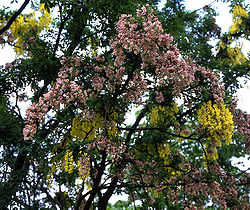
Graft-chimaera
Encyclopedia

Horticulture
Horticulture is the industry and science of plant cultivation including the process of preparing soil for the planting of seeds, tubers, or cuttings. Horticulturists work and conduct research in the disciplines of plant propagation and cultivation, crop production, plant breeding and genetic...
, a graft-chimaera may arise in grafting
Grafting
Grafting is a horticultural technique whereby tissues from one plant are inserted into those of another so that the two sets of vascular tissues may join together. This vascular joining is called inosculation...
at the point of contact between rootstock
Rootstock
A rootstock is a plant, and sometimes just the stump, which already has an established, healthy root system, used for grafting a cutting or budding from another plant. The tree part being grafted onto the rootstock is usually called the scion...
and scion and will have properties intermediate to those of its "parents". A graft-chimaera is not a true hybrid but a mixture of cells, each with the genotype
Genotype
The genotype is the genetic makeup of a cell, an organism, or an individual usually with reference to a specific character under consideration...
of one of its "parents": it is a chimaera
Chimera (plant)
Chimeras in botany are usually single organisms composed of two genetically different types of tissue. They occur in plants, on the same general basis as with animal chimeras...
. Hence, the once widely used term "graft-hybrid" is not descriptive; it is now frowned upon.
Propagation is by cloning only. In practice graft-chimaeras are not noted for their stability and may easily revert back to one of the "parents".
Nomenclature
Article 21 of the ICNCPInternational Code of Nomenclature for Cultivated Plants
The International Code of Nomenclature for Cultivated Plants regulates the names of cultigens...
stipulates that a graft-chimaera can be indicated either by
- a formula: the names of both "parents", in alphabetical order, joined by the plus sign "+":
- Crataegus + Mespilus
- a name:
- if the "parents" belong to different generaGenusIn biology, a genus is a low-level taxonomic rank used in the biological classification of living and fossil organisms, which is an example of definition by genus and differentia...
a name may be formed by joining part of one generic name to the whole of the other generic name. This name must not be identical to a generic name published under the ICBN. For example +Crataegomespilus+Crataegomespilus+Crataegomespilus is the generic name applied to graft-chimeras between the genera Crataegus and Mespilus. It is not to be confused with ×Crataemespilus, which is applied to sexual hybrids between those genera, nor with Chamaemespilus which is a segregate genus or subgenus of Sorbus....
is the name for the graft-chimaera which may also be indicated by the formula Crataegus + Mespilus. This name is clearly different from ×Crataemespilus, the name under the ICBN for the true hybrid between Crataegus and Mespilus, which can also be designated by the formula Crataegus × Mespilus. - if both "parents" belong to the same genus the graft-chimaera may be given a cultivarCultivarA cultivar'Cultivar has two meanings as explained under Formal definition. When used in reference to a taxon, the word does not apply to an individual plant but to all those plants sharing the unique characteristics that define the cultivar. is a plant or group of plants selected for desirable...
name. For example Syringa 'Correlata' is a graft-chimaera involving Syringa vulgaris (common lilac) and Syringa ×chinensis (Rouen lilac, which is itself a hybrid between S. vulgaris and S. laciniata). No plus sign is used, because both "parents" belong to the genus Syringa.
- if the "parents" belong to different genera
- a name:
A graft-chimaera cannot have a species
Species
In biology, a species is one of the basic units of biological classification and a taxonomic rank. A species is often defined as a group of organisms capable of interbreeding and producing fertile offspring. While in many cases this definition is adequate, more precise or differing measures are...
name, because it is simultaneously two species. Although +Laburnocytisus 'Adamii'
+Laburnocytisus 'Adamii'
+Laburnocytisus 'Adamii' is a horticultural curiosity; a small tree which is a graft-chimaera between two species, a laburnum, Laburnum anagyroides, and a broom, Chamaecytisus purpureus +Laburnocytisus 'Adamii' (also known as Adam's laburnum or broom laburnum) is a horticultural curiosity; a...
, for example, is sometimes seen written as if it were a species (+Laburnocytisus adamii), this is incorrect.
In Darwin's works
Charles Darwin «The Variation of Animals and Plants Under Domestication», 1868 г.:I will therefore give all the facts which I have been able to collect on the formation of hybrids between distinct species or varieties, without the intervention of the sexual organs. For if, as I am now convinced, this is possible, it is a most important fact, which will sooner or later change the views held by physiologists with respect to sexual reproduction. A sufficient body of facts will afterwards be adduced, showing that the segregation or separation of the characters of the two parent-forms by bud-variation, as in the case of Cytisus adami, is not an unusual though a striking phenomenon. We shall further see that a whole bud may thus revert, or only half, or some smaller segment.

